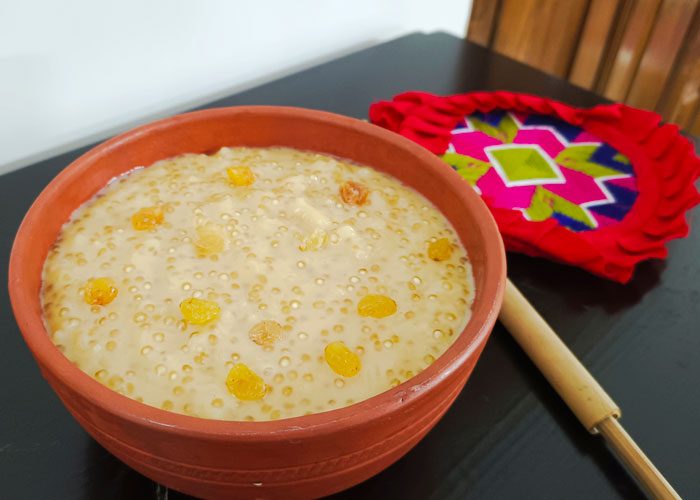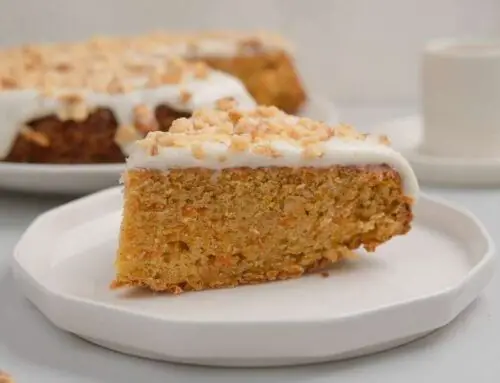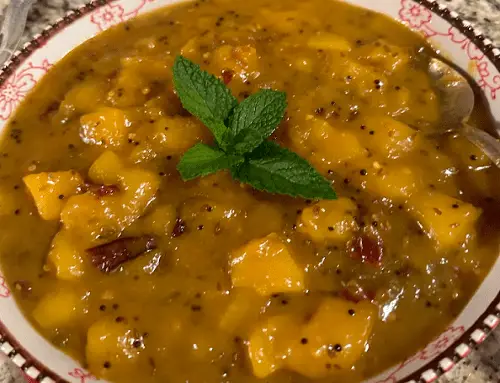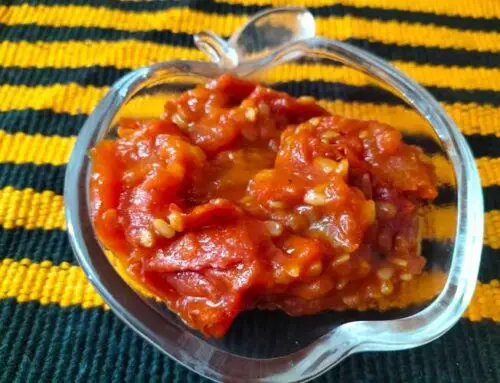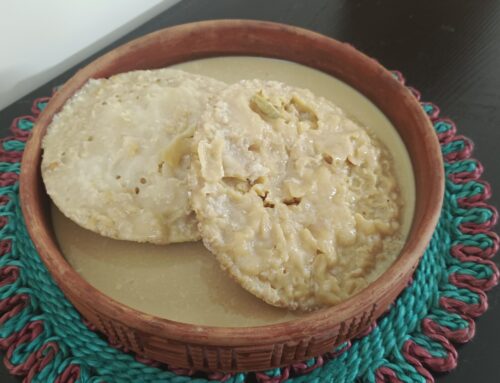Firni supposedly originated from the middle east, specifically in Mughal cuisine. But there’s something that makes the dish very local, very Bangladeshi. Then I thought maybe Sago Firni is a Bangladeshi rendition of the Mughal dish. But sago is not local either, it comes from Sago palm trees of Indonesia and New Guinea. So I have no idea how these two ingredients from very different regions came together to form the delicacy that is Sago Firni.
Sago Firni differs from normal Firni just in ingredients. Sago Firni has Sago in it with some rice, while normal Firni has only Polao Chaal. The chaal (rice) could be polao, bashmati or anything of the sort but not Sago. As sago or rice are the main ingredients, which one you use affects the taste and texture a lot. But the sweet, milky taste stays. And of course the badam(nuts) or raisins you use will enhance the taste.
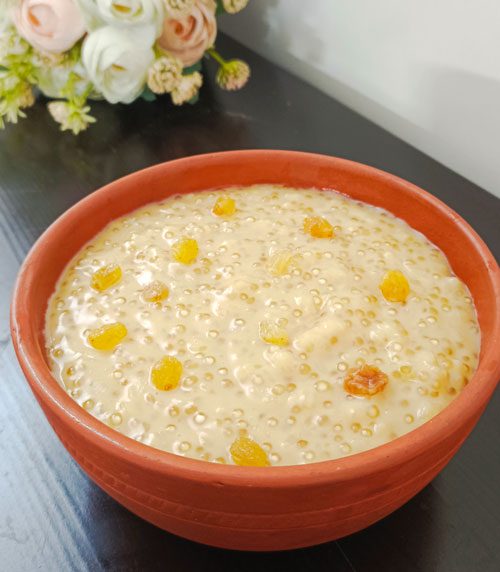 I called Firni a Bangladeshi dish because it’s associated with our cuisine so much. And not just a dessert, it has so many emotions entangled with it. Desserts are mostly just sweets. Bangladeshi people are most accustomed to bakery sweets as deserts. Doi (yogurt) is also another popular dessert. But these are just desserts, you can have them almost anytime.
I called Firni a Bangladeshi dish because it’s associated with our cuisine so much. And not just a dessert, it has so many emotions entangled with it. Desserts are mostly just sweets. Bangladeshi people are most accustomed to bakery sweets as deserts. Doi (yogurt) is also another popular dessert. But these are just desserts, you can have them almost anytime.
But Firni is not something you can have on any Tuesday. Buying cups of Firni is not really customary. And bought firni doesn’t taste as good as homemade Firni, no matter where you buy it from. It may taste good but it will lack the magic. And what magic am I talking about? The magical smell of polao er chaal and milk, the wait for it to finish, then watching mother decorate it. Now comes the time to decide: do you have the Firni while it is still hot or wait for it to cool down. Usually the answer is to have some hot Firni while the rest cools down.
So Firni isn’t just made everyday. It’s either made on special occasions or it turns the day into a special occasion when made. And the note of special occasions, Firni is arguably the second most popular dessert of Eid, the biggest festivity of Bangladesh.
Friends and family visit each other and are greeted with Firni. On these times the dish transcends from just a food item, it creates memories, it creates bonds.
Eid is not the only event that is associated with Firni, it’s also a popular dessert for weddings. Weddings in Bangladesh are huge, it’s more than just the couple’s most important day. It’s a festival of two families, it is a social statement of the bourgeoisie. So what food is being served really matters because that is what the guests talk about afterwards. And I guess you can understand how significant a dessert has to be to be included in the menu of a wedding.
Speaking of weddings and Firni, I have a distinct and close to my heart memory. My own sister’s wedding had Firni as the dessert and it was absolutely delicious. Everyone, I mean literally every guest liked it. Some relatives were against the idea of Firni and wanted something more mainstream like doi-misti. But I insisted and I’m so glad it worked out. So it goes without saying that Firni has a sentimental spot for me.
Another thing you should know about Firni is that there is some segregation regarding the dish. Every community eats it but in particular cases you’ll see Firni being more popular in Muslim households, as I already said Firni is one of the main characters of Eid. Hindu households on the other hand tend to prefer Payesh, another rice and milk based dessert. You won’t see Firni being served in Temples, Payesh is the dish of choice there. But there is no hard and fast or untold rule about who and where Payesh/Firni can be served. Hindu weddings serve Firni and Muslim households love Payesh too.
I have been talking just about Firni, not Sago Firni. Because they’re basically the same and the choice comes down to individual preference. And I will pick Firni over Sago Firni any day of the week. Hence my bias is making your read only about Firni.
I am also not a fan of Sago itself. But it is really healthy. Indigestion, heart disease, irregular blood pressure, reducing risk of diabetes – all are the benefits of Sago. So many people, even my father, eat Sago just for health care. And it’s pretty easy to eat Sago, you just have to boil it in water. There are other ways and “delicious” dishes. I don’t like any of them. The taste, chewiness of Sago just doesn’t feel right to me.
Sago Firni is probably the best I can take of Sago. But millions of people love it so do give it a shot. And I recommend having it cold.
Ingredients
- 1 cup Sago
- 2 liter Milk
- 1 Cup Jaggery
- 1 Pc Bay leaf
- 2 Pc Cardamom
- 1/4 Cup Golden Raisin
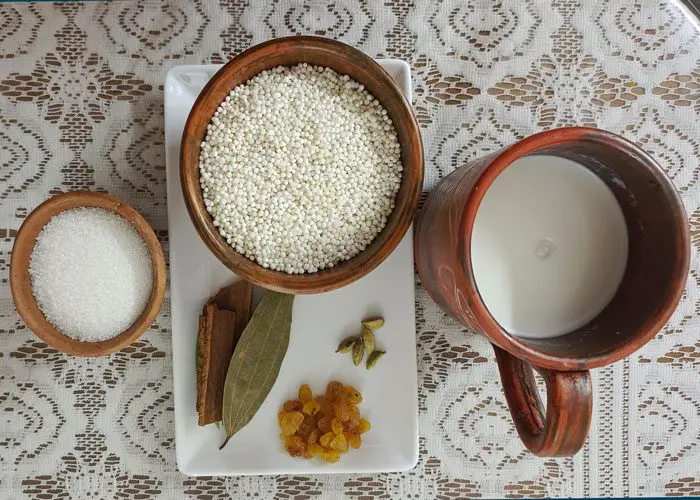
Instructions
- Clean the sago very carefully. It is recommended to change the water 2 or 3 times while cleaning the sago.
- Take some water in a pan and add sago. Boil it for 10-15 minutes. The sago will be properly boiled when all the sago becomes transparent in color
- Cut the jaggery into small pieces. Add them to the pan and mix with the sago. After mixing properly turn off the flame and keep the pan aside
- Heat the milk in another pan. Keep the flame low and stir it occasionally. Boil it for 15 to 20 minutes on low heat.
- Add the milk to the sago and jaggery mixture. Cook for 10 minutes. Stir it frequently. Add some golden raisins and turn off the flame.
- Decorate the dish with raisins (you can use almonds or anything for decoration) and serve as a tasty dessert.
Notes
Nutrition

